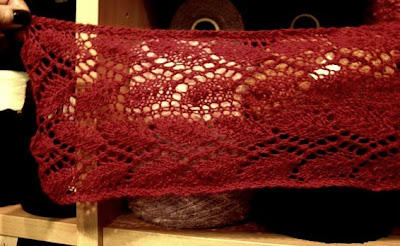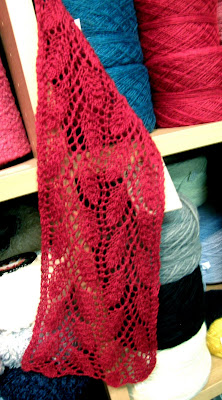Paistab, et ürbid on viimasel ajal lemmikteema (nii minu kui teiste oma). Mulle kirjutatakse aeg-ajalt ja esitatakse küsimusi, eriti kui minu lõng ei ole kõige tavalisem (nt eesti lõngad maailma teises otsas või mõni tundmatu etiketita lõng nagu
siin).
It appears that wrap jackets have recently become a favourite topic (both of mine and other people). From time to time I get letters with questions, especially if my yarn is not very common (for instance, Estonian wools in further parts of the world or some unknown yarn without label like here).Vaatame uuesti musta ürbi konstruktsiooni (loodan, et nüüd on joonis selge) ja mida see meile lubab. Kõik öeldu käib ka tavalise nelinurkse ürbi kohta (vt pilte
siin).
Let us consider the construction of the black wrap again (I hope the drawing is more clear this time) and what it gives us. Everything is valid about a usual rectangular wrap as well (see drawings here).

1. Olgu öeldud, et täpselt sama lõnga puudumine ei ole takistus. See teebki kudumise huvitavaks: sama muster, aga teine lõng annab hoopis teistsuguse, võib-olla hoopis vägevama tulemuse. Tean, et siis küsitakse, aga mitu silmust luua, kuna lõng on teine ja kudumistihedus on teine. Minu vastus: kui muster ja lõng sobivad kokku, kui koepind on sobiv, siis on kõik korras, sest ürp juba oma olemuselt ei vaja väga täpset figuuri järgi sobitamist ja ei pea midagi väga radikaalselt ümber kalkuleerima.
1. Let it be stated that the lack of the exactly same yarn is not an obstacle. This is what makes knitting exciting: the same stitch pattern but a different yarn yields a completely different, maybe even better result. I know that the next question will be: how many stitches to cast on because the yarn and the gauge is different. My answer: if the stitch pattern goes well with the yarn and the fabric is to your liking, everything is fine because wrap jacket does not need much shaping and you do not have to make radical re-calculations.2. Oletame, et alustate põiki (kõige tavalisem konstruktsioon). Kui on kahtlus, parem luua rohkem silmuseid. Kui on mõnda aega kootud ja on olemas juba 10-15 cm laiune riba, vaadake, kas pole liiga lühike. Kui tundub pikk, pikkus võib minna kraesse. S.o. hetkel, kui on vaja otsustada, kus on käeauk, eraldate kraele rohkem silmuseid. See ei tee inetumaks, vaid hoopis vastupidi, kraega saab mängida.
2. Suppose you start sideways (the most common construction). If you are in doubt, cast on more stitches. Once you have knitted for some time and have some 10-15 cm, make sure the length is not too short. If it appears long, the extra length can be transferred to the collar. That is, at the moment when you have to decide where to place the armhole, you can allocate more stitches for the collar. It will not make your wrap uglier, on the contrary, later you can play with the collar.3. Kuna ürp ei vaja erilist sobitamist figuuri järgi, avaneb tohutu võimalus mustrite valimiseks. Pind on suur.
3. Whereas wraps do not need shaping, you have a great opportunity to choose stitch patterns. The fabric surface is large.4. Ürpe on üsna palju ajakirjades ja ka poodides. Võib uurida õpetusi mitte niivõrd selle pilguga, kui palju silmuseid luua, vaid pigem vaadata proportsioone: üldmõõtmed, käeaugu pikkus, krae pikkus. Poes võib selga proovida ja vaadata, milline pikkus sobib (mul on mõõdulint ja märkmik alati kaasas).
4. There are many wrap jackets in knitting magazines and also in stores. You can study the patterns not for the number of stitches to be cast on but rather for proportions: overall measures, the length of the armhole, the length of the collar. In a store you can try on and see which length is good (I always carry a measuring tape and a notebook with me).5. Luban, et ürpe ja nendeteemalisi kirjutisi tuleb veel.
5. I promise that I will have more wraps knitted and have more wrap-related posts.









































